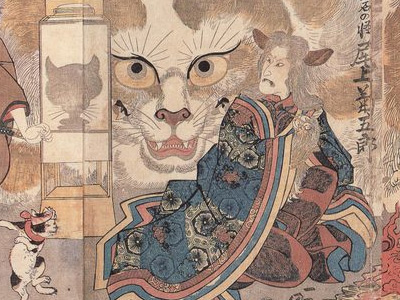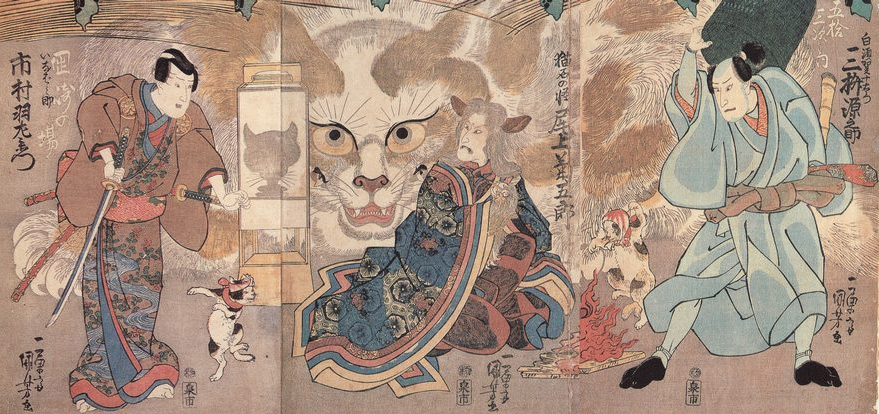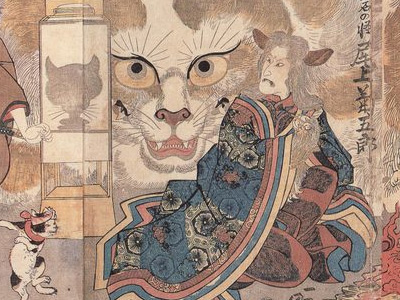Bakeneko (化け猫 changed cat)

According to its name, it is a cat that has changed into a yōkai. It is often confused with the nekomata, another cat-like yōkai, and the distinction between the two can often be quite ambiguous. There are legends of bakeneko in various parts of Japan Japan is an island country in East Asia. Beginning in the 12th century, political power was held by a series of military dictators (shōgun) and feudal lords (daimyō) and enforced by a class of warrior nobility (samurai). In the Meiji period, the empire adopted a Western-modeled constitution and pursued a program of industrialization and modernization. A global leader in the automotive, robotics and electronics industries, Japan has made significant contributions to science and technology. , but the tale of the Nabeshima Bakeneko Disturbance in Saga Prefecture is especially famous.
Japan is an island country in East Asia. Beginning in the 12th century, political power was held by a series of military dictators (shōgun) and feudal lords (daimyō) and enforced by a class of warrior nobility (samurai). In the Meiji period, the empire adopted a Western-modeled constitution and pursued a program of industrialization and modernization. A global leader in the automotive, robotics and electronics industries, Japan has made significant contributions to science and technology. , but the tale of the Nabeshima Bakeneko Disturbance in Saga Prefecture is especially famous.
Origin
The reason that cats are seen as yōkai in Japanese mythology is attributed to many of the characteristics that they possess: for example, the way the irises of their eyes change shape depending on the time of day, the way their fur seems to cause sparks due to static electricity when they are petted (especially in winter), the way they sometimes lick blood, the way they can walk without making a sound, their wild nature that remains despite the gentleness they can show at times, the way they are difficult to control (unlike dogs), the sharpness of their claws and teeth, their nocturnal habits, and their speed and agility.
There are many yōkai animals other than cats in old tales that have similar attributes: the deep tenacity of snakes, the ability of foxes (kitsune) to shapeshift into women, and the brutality of tanuki in eating humans depicted in the Kachi-kachi Yama folktale from the Edo period. Cats in particular, however, have acquired a great number of tales and superstitions surrounding them, due to the unique position they occupy between nature and civilization. As cities and towns were established and humans began living farther apart from nature, cats came with them. Since cats live close to humans yet retain their wild essence and air of mystery, stories grew up around them, and gradually the image of the bakeneko was formed.
One folk belief concerning the bakeneko is that they would lick the oil of oriental lamps, and in the Edo period encyclopedia, the Wakan Sansai Zue, it is said that for a cat to lick this oil is an omen of some strange event about to occur. People in the early modern period used cheap oils from fish, like sardine oil, in the lamps, and that could explain why cats would want to lick them. Also, the diet of Japanese people at that time was based mainly on grains and vegetables, and the leftovers would be fed to the cats. However, since cats are carnivores, such a diet would have been lacking in protein and fat, and therefore they would have been even more attracted to the oil in the lamps. Furthermore, the sight of a cat standing up its hind legs to reach the lamp, with its face lit up and eyes round with anticipation, could have seemed eerie and unnatural, like a yōkai.
The mysterious air that cats possess was associated with the image of prostitutes who worked in the Edo period red-light districts. This was the origin of a popular character in kusazōshi (among other publications), the bakeneko yūjo.
Folk Legends
As with the nekomata, another cat-like yōkai which is said to derive from a cat whose tail split into two when it grew older, there are folk beliefs across Japan about how aged cats would turn into bakeneko. There are tales of cats raised for twelve years in Ibaraki Prefecture and Nagano Prefecture, and for thirteen years in Kunigami District, Okinawa Prefecture, that became bakeneko. In Yamagata District, Hiroshima Prefecture, it is said that a cat raised for seven years or longer would kill the one that raised it. There are also many regions where when people began raising a cat, they would decide in advance for how many years they would raise it because of this superstition. Also, depending on the area, there are stories in which cats that were killed by humans in a brutal manner would become bakeneko and curse that human. The stories of bakeneko are not only about aged cats, but are also sometimes stories of revenge against cruel humans.
The abilities attributed to the bakeneko are various, but include shapeshifting into humans, wearing a towel or napkin on the head and dancing, speaking human words, cursing humans, manipulating dead people, possessing humans, and lurking in the mountains and taking wolves along with them to attack travelers. As an unusual example, on Aji island, Oshika District, Miyagi Prefecture and in the Oki Islands, Shimane Prefecture, there is a story of a cat that shapeshifted into a human and wanted to engage in sumo.
However, concerning the legend that cats could speak, it has been pointed out that it may have arisen because humans would misinterpret the cat's meowing as human language, and for this reason some would say that the cat is not a type of yōkai. In 1992 (Heisei 4), in the Yomiuri newspaper, there was an article that argued that when people thought they had heard a cat speak, upon listening a second time, they realized that it was simply the cat's meowing and that it was only coincidence that it resembled a word in human language.
In the Edo period (1603-1867), there was a folk belief that cats with long tails like snakes could bewitch people. Cats with long tails were disliked and there was a custom of cutting their tails. It is speculated that this is the reason that there are so many cats in Japan with short tails nowadays, because natural selection has favored those with short tails.
Folk beliefs that cats can cause strange phenomena are not limited to Japan. For example, in Jinhua, Zhejiang, in China, it is said that a cat, after having been raised for three years by humans, would then start bewitching them. Because it is said that cats with white tails are especially good at this, there arose the custom of refraining from raising white cats. Since it is said that their ability to bewitch humans comes from taking in the spiritual energy of the moon, it is said that when a cat looks up at the moon, whether its tail has been cut or not, it should be killed on the spot.
Writings and literature
There is a legend that takes place in the time of Nabeshima Mitsushige, the second daimyo of the Saga Domain, Hizen Province, concerning the bakeneko. Mitsushige's retainer Ryūzōji Matashichirō served as the daimyo 's opponent in the game of go. Ryūzōji displeased Mitsushige and was put to the sword. Ryūzōji's mother, while telling of the sorrows in her heart to the cat that she raised, committed suicide. The cat licked the mother's blood and became a bakeneko. It would go into the castle and torment Mitsushige every night. Mitsushige's loyal retainer Komori Hanzaemon finally killed it and saved the Nabeshima family.
Historically, the Ryūzōji clan was older than the Nabeshima clan in Hizen. After Ryūzōji Takanobu's death, his assistant Nabeshima Naoshige held the real power, and after the sudden death of Takanobu's grandchild Takafusa, his father Masaie also committed suicide. Afterwards, since the remnants of the Ryūzōji clan created disturbances in the public order near the Saga castle, Naoshige, in order to pacify the spirits of the Ryūzōji, built Tenyū-ji (now in Tafuse, Saga). This has been considered the origin of the disturbance and it is thought that the bakeneko was an expression of the Ryūzōji's grudge in the form of a cat. Also, the inheritance of power from the Ryūzōji clan to the Nabeshima clan was not an issue, but because of Takanobu's death, and Nabeshima Katsushige's son's sudden death, some point out that this kaidan (ghost story) arose from a dramatization of this series of events.
This legend was also turned into a shibai (play) afterwards. In the Kaei period (1848–1854), it was first performed in Nakamura-za as "Hana Sagano Nekoma Ishibumi Shi" (花嵯峨野猫魔碑史). The "Sagano" in the title is a place in Tokyo Prefecture, but it was actually a pun on the word saga. This work earned great popularity throughout the whole country, but due to a complaint from the Saga domain, the performances were quickly stopped. However, since the machi-bugyō(a samurai official of the shogunate) who filed the complaint for the performances to be stopped was Nabeshima Naotaka of the Nabeshima clan, the gossip about the bakeneko disturbance spread even more.
After that, the tale was widely circulated in society in the kōdan "Saga no Yozakura" (佐賀の夜桜』) and the historical record book "Saga Kaibyōden" (佐賀怪猫伝). In the kōdan (a style of traditional oral Japanese storytelling), because Ryūzōji's widow told of her sorrow to the cat, it became a bakeneko, and killed and ate Komori Hanzaemon's mother and wife. It then shapeshifted and appeared in their forms, and cast a curse upon the family. In the historical record book, this was completely unrelated to the Ryūzōji event, however, and a foreign type of cat, which had been abused by Nabeshima's feudal lord Komori Handayū, sought revenge and killed and ate the lord's favorite concubine, shapeshifted into her form, and caused harm to the family. It was Itō Sōda who exterminated it.
In the beginning of the Shōwa period (1926–1989), there were kaidan films such as the "Saga Kaibyōden" (佐賀怪猫伝) and the "Kaidan Saga Yashiki" (怪談佐賀屋敷) that became quite popular. Female actors like Takako Irie and Sumiko Suzuki who played the part of the bakeneko became well known as the "bakeneko actresses."
Other
Cats as yōkai in literature date back to the Kamakura period (1185–1333). In the collection of setsuwa (oral tradition of folktales before the 14th century), the Kokon Chomonjū, from this period, there can be seen statements pointing out cats that do strange and suspicious things, noting that "these are perhaps ones that have turned into demons." Old stories about bakeneko from that time period are often associated with temples, but it is thought that the reason for this is that when Buddhism came to Japan, in order to protect the sutras (sacred texts) from being chewed on by rats, cats were brought along too.

Ume no Haru Gojūsantsugi (梅初春五十三駅) by Utagawa Kuniyoshi. A kabuki that was performed in 1835 (Tenpo 6) in Ichimura-za. It depicts a cat that has shapeshifted into an old woman, a cat wearing a napkin and dancing, and the shadow of a cat licking a lamp
During the Edo period (1603–1867), tales about bakeneko began to appear in essays and kaidan collections in various areas. Tales of cats transforming into humans and talking can be seen in publications like the "Tōen Shosetsu" (兎園小説), the "Mimibukuro" (耳嚢), the "Shin Chomonjū" (新著聞集), and the "Seiban Kaidan Jikki" (西播怪談実記). Similarly, tales of dancing cats can be seen in the "Kasshi Yawa" (甲子夜話), and the "Owari Ryōiki" (尾張霊異記). In the fourth volume of "Mimibukuro," it is stated that any cat anywhere that lives for ten years would begin to speak as a human, and that cats born from the union of a fox and a cat would begin speaking even before ten years had passed.
According to tales of cats that transform, aged cats would very often shapeshift into old women. The Edo period was the golden age for kaidan about bakeneko, and with shibai like the "Nabeshima Bakeneko Disturbance" being performed, these became even more famous.
In Makidani, Yamasaki, Shisō District, Harima Province (now within Shisō, Hyōgo Prefecture), a tale was passed down about a person in Karakawa who was a bakeneko. The same kind of tale was also found in Taniguchi, Fukusaki village, Jinsai District, of the same province, where it is said that in Kongōjō-ji, a bakeneko who troubled a villager was killed by someone from the temple. This bakeneko was protected from arrows and bullets by a chagama 's lid and an iron pot. These, like the legend of Susanoo's extermination of Yamata no Orochi, have a commonality in that the local old families of the area played a role.
In 1909, articles about cats that broke into dance in tenement houses in the Honjo neighbourhood of Tokyo were published in newspapers such as the Sports Hochi, the Yorozu Chōhō, and the Yamato Shimbun.
LEGENDS

RESOURCES
This article uses material from the Wikipedia article "Bakeneko (化け猫 changed cat)", which is released under the Creative Commons Attribution-Share-Alike License 3.0.
© Stories Preschool. All Rights Reserved.









